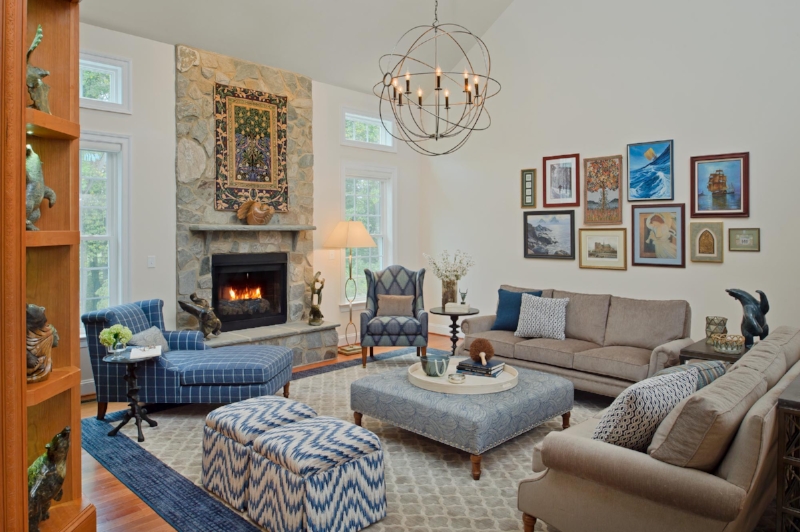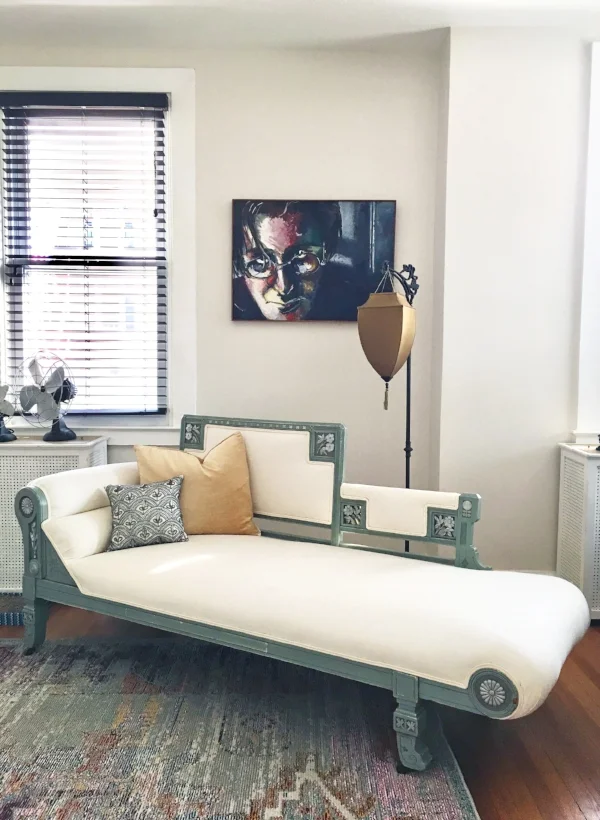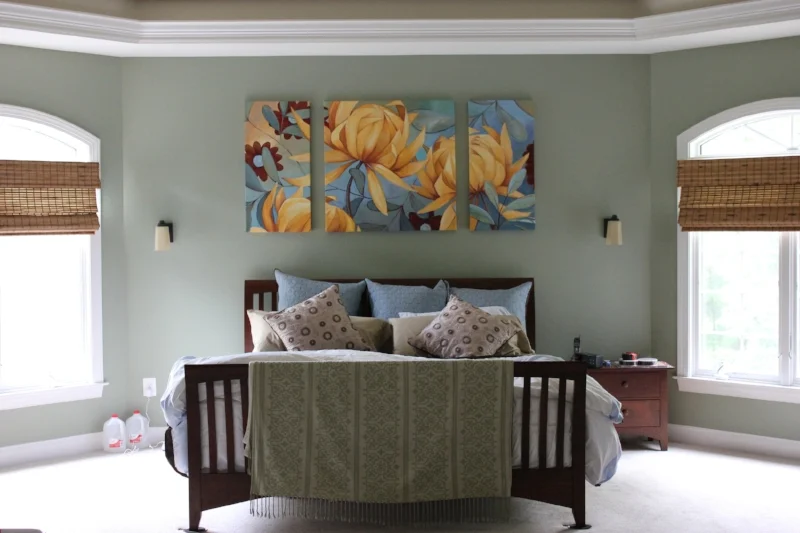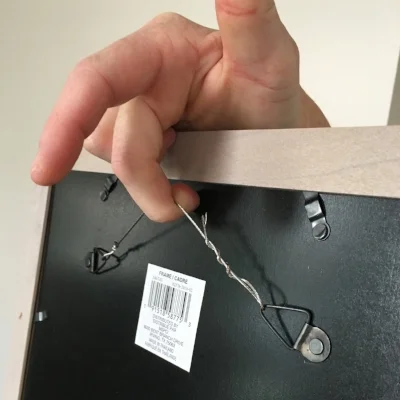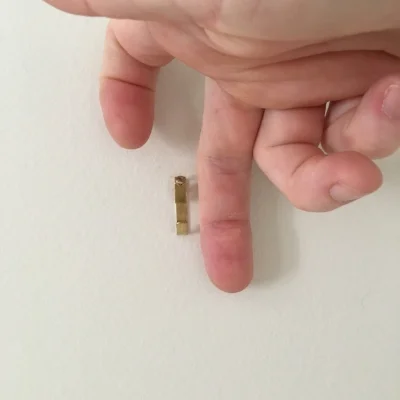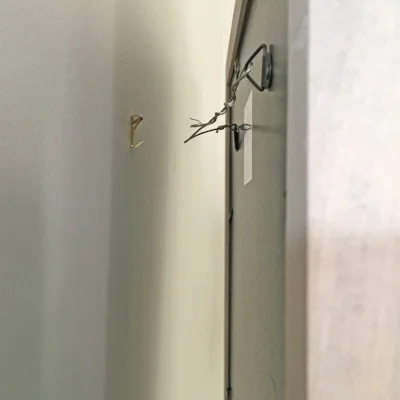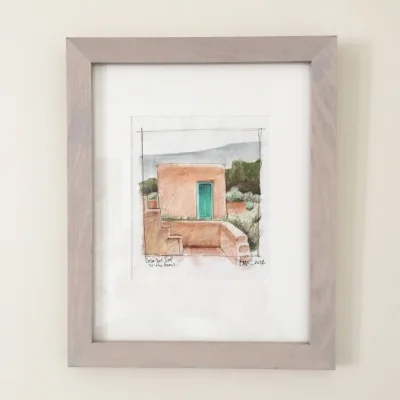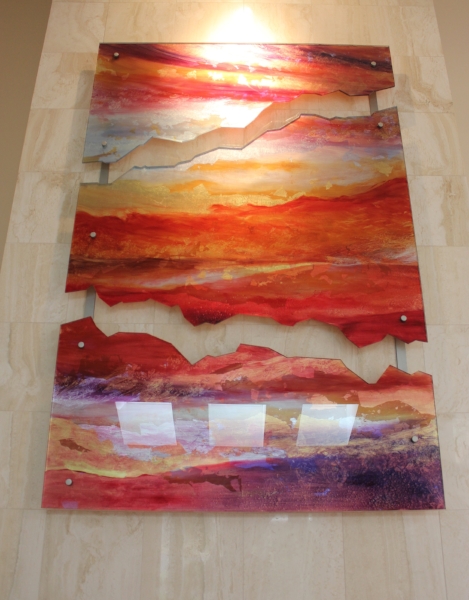Welcome to the third and final installment in this series. At this point you’ve luckily found your perfect work of art, possibly met the artist, and now its time to hang it. Where do you start?
A pair of complimenting abstracts commissioned by a client for their two story family room. Each measures 7’ tall by 9’ wide! (Oh, and I wood grained the coffered ceiling too.)
Recently, a friend came to me with a question about a painting he bought in Colombia from an artist on the street. It isn’t stretched and he wasn’t sure what to do. A good framer will be able to mount the canvas on stretcher bars and then suggest different types of frames to compliment the piece. Or if you are handy, you might want to try stretching it yourself. A few places sell stretcher bars on line, such as Dick Blick and Cheap Joe’s. I prefer the deeper set kind, which give the piece a nice rich feel. They are sold as pairs, so you can buy the length and width you need. I won’t go into detail about the art of stretching but there are several tutorials on line to help you along.
A series of fun paintings for a client’s daughter’s bedroom. Designs were based on the bedding.
Framing is the fun part. Its like picking out your accessories for your outfit. I prefer understated frames that compliment the art. Floating frames are gorgeous for canvas works, I used black frames on my series, “Still Standing,” which was framed by Mat About You, shown below.
A few of my pieces from “Still Standing” on display.
The style of frame is up to you. Ornate gold frames look good in traditional spaces while clean simple frames look good with more transitional or modern decor. But there are no rules really. I've seen very successful groupings with a variety of style frames that are all different. Sometimes paintings are just fine without a frame. This style is called “gallery wrapped” and is when the sides are either painted a solid color or the image wraps around the sides.
Gallery wrapped canvas. Private Commission
What if you have a watercolor or drawing? Typically theses types of works are framed under glass to protect the fragility of the media. A nice wide mat in a neutral color should set off the piece. I steer away from fancy, stacked mats with intricate cuts and bright colors because I think they distract from the art, but thats just me. A good framer shouldn’t sell you on the most expensive frame, but rather suggest options that set off the art and work within your budget, and most importantly a frame that’s appropriate for the value of the piece. You don’t want to pay $400 for a $40 drawing!
My drawing “Double Fiddle” framed in an understated stacked white mat with simple black frame. Flanked by “Around Back” and “Rust and Dust.” Framed by Mat About You.
The hard part is how to hang it. Many people think hanging art high on the wall is correct. When was the last time you were in a museum? Do you remember how the art was hung? Well if its not salon style, (where art covers every last inch of the wall, floor to ceiling) then its typically at eye level.
A great example of a grouping of pieces. Interior Design by April Force Pardoe Interiors
If you're hanging artwork over a piece of furniture like a bed or a couch, the space between the top and the bottom of the art with the ceiling is important. Taller ceilings like the one above can be tricky. Bring the grouping closer to the couch so that it relates to the space and doesn’t seem floating.
My living room- a painting I created in high school hangs behind a floor lamp and chaise. The art is overlapped by the lamp, creating a layered look, and the art is low enough to relate to the surroundings.
In the space above, the art is centered between the ceiling and the bed because the ceiling is lower and it would have felt cramped to hang the artwork any lower. Commissioned work, “Dancing Chrysanthemums”
Whenever I hang art, I try to have help. I’ll ask them to hold the piece up in place so that I can stand back and see how it looks. I’ll take a photo too because its very helpful to see things that aren’t noticed in person. If I’m alone, I will cut a piece of craft paper the size of the painting and tape it up on the wall. This is also helpful if you are hanging multiples and don’t have enough floor space to lay everything out. Its much easier to adjust the pieces of paper rather than putting a million holes in your wall.
Hang the wire on the first knuckle then hold up to the wall where you want it.
If I’m hanging smaller pieces, I’ll hook the wire in my finger and hold it up where I want it. Next, I’ll take the painting down and leave my hand in place. Where the wire was resting on my finger is where I put the nail. For larger pieces, I’ll take a tape measure and hook it to the wire and pull up to measure the distance from the wire to the outside edge of the frame. Add that measurement to the top edge of your piece of paper and mark your spot. Thats where you will put your nail.
I’ve placed the hook in the wall level with where my knuckle rests.
For example: Say the distance from the ceiling to the top of your painting is 60”. The measurement of the wire to the top of your painting is 6”. The total distance from the ceiling to the hook is 66”. Place your hook at 66” and your painting should be hung perfectly.
Hook the wire on the hook.
Pro tip: If your painting is in a hallway and is easily knocked off level, use some museum putty or rubber stoppers (both found at hardware stores) to anchor the corners to the wall.
Stand back and admire!
Not finding that piece that feels "just right?" Then commission Lenehan Studios to create one for you. We can work within your budget and color scheme to design a piece that looks like it was meant to be. Like that perfect pair of shoes.
A unique commissioned work on glass.






